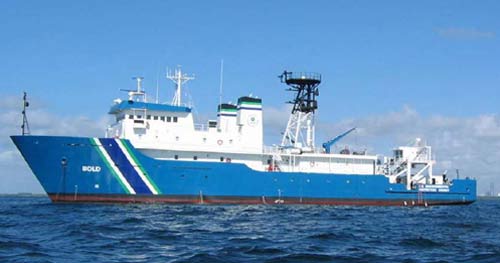
This week we’re focusing on OSV Bold, one of EPA’s research ships. Two usually shore-based EPA staffers, Margot Perez-Sullivan and Margaret Ford, went out on the ship with the researchers a couple of weeks ago with one goal: come back and share what it’s like. They wrote and photographed each day, but had no Internet access at sea, so we’re posting their blog entries this week. And the EPA folks will read and respond to comments all week. We’ll resume our usual blog features next week: Question of the Week, Science Wednesday, and Lina’s multilingual musings. Let us know whether this kind of in-depth reporting floats your boat! — Jeffrey Levy, Greenversations editor.
Day 1 (9.5.08):
I’ve never been on a cruise. Never spent the night on a boat…at best it was a ferry here and there or the random tourist trap night cruise. When I found out I was invited to tag along and document science and research in action on the EPA’s Ocean Survey Vessel (OSV) Bold, I was thrilled. And a little scared.
The EPA uses the OSV Bold to monitor coastal waters throughout the United States. This summer marks the Bold’s maiden voyage to the west coast and this is her last survey before returning to the eastern seaboard. The Bold has an enormous mission and its surveys are carefully planned to maximize monitoring and research year-round. The Bold is 224 feet long, has a full crew of 18 and can accommodate up to 19 scientists on any one survey.
Our west coast scientists are excited to have the research vessel on this side of the country and are taking every opportunity possible to get out to sea and conduct research and sampling surveys on the Pacific.
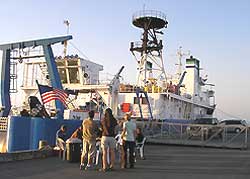 A team of nine scientists descended upon Eureka, California this September and began mobilizing for the upcoming Humboldt Open Ocean Disposal Site (HOODS) survey. HOODS is an ocean disposal site for dredged materials. West coast ports are the gateway to Asia; the Port of Los Angeles alone receives 50% of the nation’s foreign goods. These mega ships need deep ports to come into, which is where dredging and ocean disposal sites come into play. In a nut shell, sites like HOODS receive sands and sediments from local ports that need to move this material to make sure large ships can come into ports. A sediment testing program is in place to make sure that only clean, nontoxic sediments are taken to HOODS.
A team of nine scientists descended upon Eureka, California this September and began mobilizing for the upcoming Humboldt Open Ocean Disposal Site (HOODS) survey. HOODS is an ocean disposal site for dredged materials. West coast ports are the gateway to Asia; the Port of Los Angeles alone receives 50% of the nation’s foreign goods. These mega ships need deep ports to come into, which is where dredging and ocean disposal sites come into play. In a nut shell, sites like HOODS receive sands and sediments from local ports that need to move this material to make sure large ships can come into ports. A sediment testing program is in place to make sure that only clean, nontoxic sediments are taken to HOODS.
That said, during this survey, scientists are taking samples to determine the chemistry of HOODS’ sediments to confirm that the sediment testing is accurate, ensuring the sand and sediment material being dumped from the ports meets EPA standards, meaning it’s clean and doesn’t negatively impact the ecosystem near the site. Our scientists are also documenting the presence of benthic organisms (tiny sea critters that live on the ocean floor) in and around the HOODS disposal site. The results will be put together to make sure the HOODS site is being taken care of properly. VIDEO: Scientist Brian Ross discusses the survey plan.
For our marine biologists, the benthic samples will give them a good idea of the health of the ocean floor. There is a direct correlation between the types and health of these tiny ocean floor critters and the overall ocean floor environment.
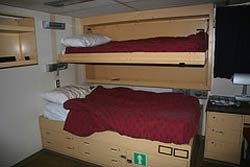 We’ve got nine environmental scientists on this survey with over 5 decades of education combined. Our nine environmental scientists are: Allan Ota, ocean disposal site expert and co-Chief Scientist; Brian Ross, ocean disposal site expert; Amy Wagner, marine biologist; Greg Nagle, chemist; Kevin Ryan, drinking water expert; Tina Yin, watersheds expert; Eugenia McNaughton, Ph.D in algae plankton and quality assurance guru; Carolyn Yale, Ph.D. watershed planner; and Chris McArthur, Chief Scientist from our Atlanta regional office.
We’ve got nine environmental scientists on this survey with over 5 decades of education combined. Our nine environmental scientists are: Allan Ota, ocean disposal site expert and co-Chief Scientist; Brian Ross, ocean disposal site expert; Amy Wagner, marine biologist; Greg Nagle, chemist; Kevin Ryan, drinking water expert; Tina Yin, watersheds expert; Eugenia McNaughton, Ph.D in algae plankton and quality assurance guru; Carolyn Yale, Ph.D. watershed planner; and Chris McArthur, Chief Scientist from our Atlanta regional office.
Margaret Ford our videographer and I are on board to document the survey.
We arrived this evening and got our room assignments, a short orientation of the survey schedule and a walk around the work areas with Allan. Often, to maximize time at sea, Bold surveys run on 24-hour operations, luckily we are only on 8 hour shifts for this survey. VIDEO: See our arrival.
We are scheduled to push off tomorrow afternoon…
|
What did you know about ocean research BEFORE you read this blog?
- Very little (63%, 94 Votes)
- Some (19%, 28 Votes)
- Quite a bit (18%, 27 Votes)
Total Voters: 149
 Loading ... |
|
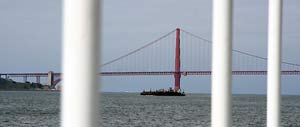 Going through the Golden Gate was amazing. We really haven’t seen the sun since we left Eureka and oddly enough, when we first spotted the Golden Gate Bridge, we actually saw that there it was sunny in San Francisco! We all went to the stern of the boat, snapping photos – everyone needs a picture of being on the boat with the Golden Gate Bridge above us! Amy’s family went to the bridge to see the ship pass through. When Captain Jere realized that someone’s family was up there, he came down, told us to plug our ears and blew the horn for them!
Going through the Golden Gate was amazing. We really haven’t seen the sun since we left Eureka and oddly enough, when we first spotted the Golden Gate Bridge, we actually saw that there it was sunny in San Francisco! We all went to the stern of the boat, snapping photos – everyone needs a picture of being on the boat with the Golden Gate Bridge above us! Amy’s family went to the bridge to see the ship pass through. When Captain Jere realized that someone’s family was up there, he came down, told us to plug our ears and blew the horn for them!
 So far, the only marine mammals we’ve seen were at seals at the dock in Eureka. Emily, one of the deck technicians on the crew spotted a whale yesterday or the day before, so we’ve all had our eyes peeled. Oddly enough, a hummingbird was flying around so Emily and Amanda (the chief steward) brought some sugar water out for the little guy. Kim, the first mate, told us that the hummingbird flew up into the bridge and flew out.
So far, the only marine mammals we’ve seen were at seals at the dock in Eureka. Emily, one of the deck technicians on the crew spotted a whale yesterday or the day before, so we’ve all had our eyes peeled. Oddly enough, a hummingbird was flying around so Emily and Amanda (the chief steward) brought some sugar water out for the little guy. Kim, the first mate, told us that the hummingbird flew up into the bridge and flew out.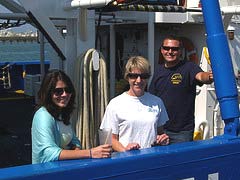 This has been a great team effort. Being on a ship is a bit like a family – we all work, eat and when we can, goof off together. The crew has been great to work with all around, very professional, friendly, they take the time to answer our questions and most importantly, they ensure our safety – correcting us if we forget a hard hat, life vest or anything else that that could put us in harm’s way. For me, the best part about this experience was getting my hands dirty while collecting data and getting to know people in our office that we might not otherwise meet in our daily work. This has been a fascinating experience, I’m anxious to see the results of the survey and I’d love to do it again.
This has been a great team effort. Being on a ship is a bit like a family – we all work, eat and when we can, goof off together. The crew has been great to work with all around, very professional, friendly, they take the time to answer our questions and most importantly, they ensure our safety – correcting us if we forget a hard hat, life vest or anything else that that could put us in harm’s way. For me, the best part about this experience was getting my hands dirty while collecting data and getting to know people in our office that we might not otherwise meet in our daily work. This has been a fascinating experience, I’m anxious to see the results of the survey and I’d love to do it again.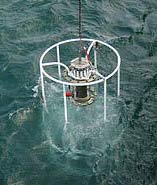 The previous shift finished all the grabs, so my shift moved onto using the CTD, which stands for Conductivity, Temperature and Depth. Sieving for critters was fun yesterday, but I was excited to do something new. A CTD measures the water’s characteristics and will be used in conjunction with the other samples to determine how the HOODS site is performing and will give scientists a better idea of water quality in the area. The CTD is deployed off the side of the ship, dropped down — almost but not quite — to the ocean floor.
The previous shift finished all the grabs, so my shift moved onto using the CTD, which stands for Conductivity, Temperature and Depth. Sieving for critters was fun yesterday, but I was excited to do something new. A CTD measures the water’s characteristics and will be used in conjunction with the other samples to determine how the HOODS site is performing and will give scientists a better idea of water quality in the area. The CTD is deployed off the side of the ship, dropped down — almost but not quite — to the ocean floor.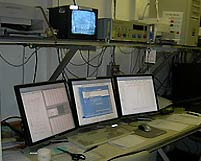 As readings are taken continuously with depth, the information is displayed real time on a computer screen and saved in a computer file in the Data Acquisition Center (DAQ). Usually a scientist and a member of the tech crew monitors the data coming in to see any important features at a particular location and make sure the device is working.
As readings are taken continuously with depth, the information is displayed real time on a computer screen and saved in a computer file in the Data Acquisition Center (DAQ). Usually a scientist and a member of the tech crew monitors the data coming in to see any important features at a particular location and make sure the device is working.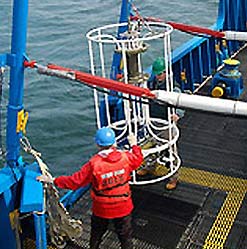 Our shift ended around 9:30. We were strictly on CTD sampling; this is by far the most nerve wracking process as two doors open and the CTD is deployed off the side of the ship – which leaves room for falling. I didn’t fall, but those who know me, are fully aware of my clumsiness on land. CTD samples aren’t hands-on the way sediment sampling and sieving samples are, but what’s really interesting is that we get the data on a computer in the Data Acquisition Center in real time and can be analyzed later.
Our shift ended around 9:30. We were strictly on CTD sampling; this is by far the most nerve wracking process as two doors open and the CTD is deployed off the side of the ship – which leaves room for falling. I didn’t fall, but those who know me, are fully aware of my clumsiness on land. CTD samples aren’t hands-on the way sediment sampling and sieving samples are, but what’s really interesting is that we get the data on a computer in the Data Acquisition Center in real time and can be analyzed later.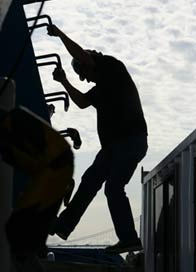 The crew is pretty diverse with 16 men and women of all ages and backgrounds. Many of the crew got into the maritime industry because of a parent or relative. They all seem to like their jobs and are very accommodating to EPA staff. It must be strange to live on a vessel that has a different people coming and going year-round, but they don’t seem to mind and are very personable.
The crew is pretty diverse with 16 men and women of all ages and backgrounds. Many of the crew got into the maritime industry because of a parent or relative. They all seem to like their jobs and are very accommodating to EPA staff. It must be strange to live on a vessel that has a different people coming and going year-round, but they don’t seem to mind and are very personable.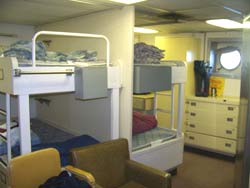 We got a chance to take a tour of the galley, commonly known as a kitchen on land. The chief steward, Amanda, is very accommodating to different dietary needs and makes us some very tasty meals. No one goes hungry on this ship!
We got a chance to take a tour of the galley, commonly known as a kitchen on land. The chief steward, Amanda, is very accommodating to different dietary needs and makes us some very tasty meals. No one goes hungry on this ship!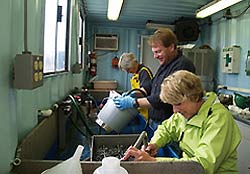 Tiger Sharks managed to get 10 sediment grabs for a total of 20 samples. It’s great to have such knowledgeable people around me that can not only tell me what all these little critters but are so passionate about their work. Amy with her infinite marine biology knowledge made the sieving go by so much faster. And I learned something. Bonus!
Tiger Sharks managed to get 10 sediment grabs for a total of 20 samples. It’s great to have such knowledgeable people around me that can not only tell me what all these little critters but are so passionate about their work. Amy with her infinite marine biology knowledge made the sieving go by so much faster. And I learned something. Bonus!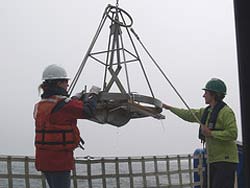 The Captain made it to the first sampling site in no time at all – but unfortunately it took four drops of the equipment to get a proper sample. The first round of samples collected had everyone really excited. For each grab a photo is taken of the sediment before it is transferred into a sieve (for the benthic organism collection) or a pan (for the chemistry analyses). My shift is from 2 pm until 10 pm, so I’m just observing during this shift to make sure I know what to do.
The Captain made it to the first sampling site in no time at all – but unfortunately it took four drops of the equipment to get a proper sample. The first round of samples collected had everyone really excited. For each grab a photo is taken of the sediment before it is transferred into a sieve (for the benthic organism collection) or a pan (for the chemistry analyses). My shift is from 2 pm until 10 pm, so I’m just observing during this shift to make sure I know what to do.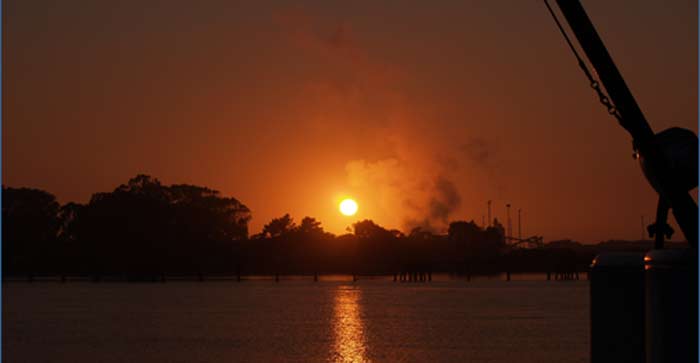

 A team of nine scientists descended upon Eureka, California this September and began mobilizing for the upcoming Humboldt Open Ocean Disposal Site (HOODS) survey. HOODS is an ocean disposal site for dredged materials. West coast ports are the gateway to Asia; the Port of Los Angeles alone receives 50% of the nation’s foreign goods. These mega ships need deep ports to come into, which is where dredging and ocean disposal sites come into play. In a nut shell, sites like HOODS receive sands and sediments from local ports that need to move this material to make sure large ships can come into ports. A sediment testing program is in place to make sure that only clean, nontoxic sediments are taken to HOODS.
A team of nine scientists descended upon Eureka, California this September and began mobilizing for the upcoming Humboldt Open Ocean Disposal Site (HOODS) survey. HOODS is an ocean disposal site for dredged materials. West coast ports are the gateway to Asia; the Port of Los Angeles alone receives 50% of the nation’s foreign goods. These mega ships need deep ports to come into, which is where dredging and ocean disposal sites come into play. In a nut shell, sites like HOODS receive sands and sediments from local ports that need to move this material to make sure large ships can come into ports. A sediment testing program is in place to make sure that only clean, nontoxic sediments are taken to HOODS. We’ve got nine environmental scientists on this survey with over 5 decades of education combined. Our nine environmental scientists are: Allan Ota, ocean disposal site expert and co-Chief Scientist; Brian Ross, ocean disposal site expert; Amy Wagner, marine biologist; Greg Nagle, chemist; Kevin Ryan, drinking water expert; Tina Yin, watersheds expert; Eugenia McNaughton, Ph.D in algae plankton and quality assurance guru; Carolyn Yale, Ph.D. watershed planner; and Chris McArthur, Chief Scientist from our Atlanta regional office.
We’ve got nine environmental scientists on this survey with over 5 decades of education combined. Our nine environmental scientists are: Allan Ota, ocean disposal site expert and co-Chief Scientist; Brian Ross, ocean disposal site expert; Amy Wagner, marine biologist; Greg Nagle, chemist; Kevin Ryan, drinking water expert; Tina Yin, watersheds expert; Eugenia McNaughton, Ph.D in algae plankton and quality assurance guru; Carolyn Yale, Ph.D. watershed planner; and Chris McArthur, Chief Scientist from our Atlanta regional office.